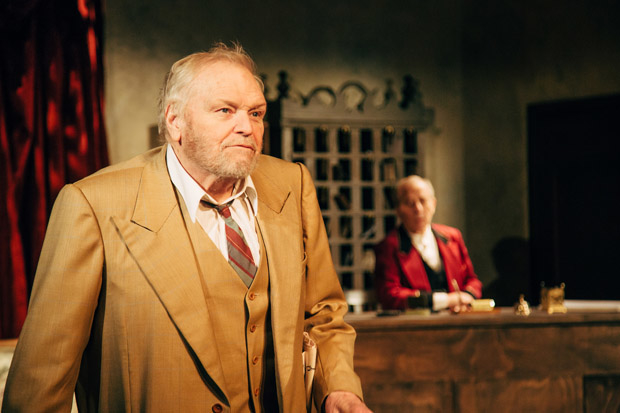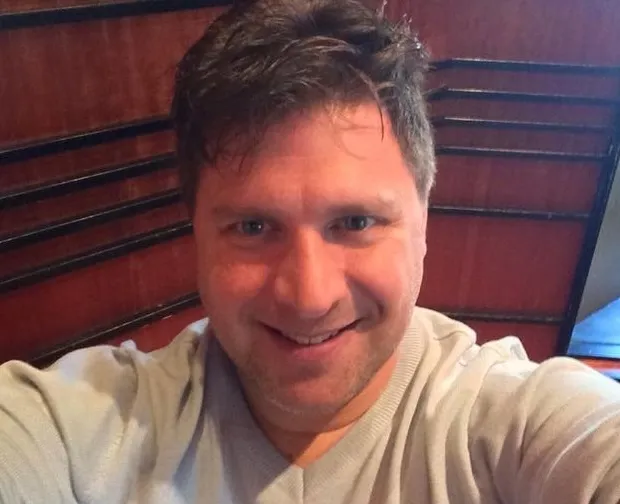Exploring Two Lost Souls in Hughie and Krapp's Last Tape
Brian Dennehy portrays characters buried in the past in classics by two theatrical masters at Geffen Playhouse.

(© Jeff Lorch)
Brian Dennehy, who won one of his two Tony Awards as iconic Eugene O'Neill protagonist James Tyrone in a 2003 production of Long Day's Journey Into Night, returns to the author's milieu with the one-act Hughie, another tale of addiction and emotional ghosts. Dennehy has paired this piece with Samuel Beckett's Krapp's Last Tape, an adept companion since both feature lonely, soused, broken men reveling in their former lives.
Hughie takes place in a seedy hotel lobby in 1928 Manhattan. Erie Smith (Dennehy) regales to a worn-out night clerk (Joe Grifasi) tales of his gambling days and his tight relationship with the past night clerk, Hughie, whose recent death led Erie to his latest alcoholic bender. Erie talks the clerk's ear off as he babbles on, avoiding the isolation of his hotel room upstairs. In Krapp's Last Tape, an elderly Irish man (Dennehy) replays old tape recordings from his younger days as he drinks and drinks. His latest recording, made after several glasses of alcohol, is an almost incoherent tirade. He throws the new recording away to return to his youthful reminiscence.
Dennehy transforms his entire body for both roles. As Erie, the braggart whose façade hides a broken man, Dennehy hunches over as if his shoulders weigh a ton, his vest buttoned up to falsify a sense of elegance. His disheveled face with a two-day beard betrays his desperate need to appear dapper. He walks slowly like every muscle aches, and his equilibrium has been shot. His stories to the clerk reveal a man who has accomplished little and is at the end of his very small rope. It is apt that the 80-year-old actor plays 65-year-old Erie, a character who has prematurely aged significantly. Grifasi, with heavy bags under his eyes, resembles a mortician more than a clerk, as if he is the last stop in Erie's life.
As Krapp, Dennehy is spryer. His face is more animated than Erie's, using a raised eyebrow to punctuate his thoughts. He attempts a dance, though it almost winds him up on the floor, and he has more spirit in him, even if it's based on drunken anger. He throws things, bananas, and tape reels like a child. Listening to his 39-year-old self has regressed him to infancy.
Director Steven Robman creates diverse moods for each play. Sibyl Wickersheimer's lobby set for Hughie contains a low roof for a claustrophobic feeling, ornate Moroccan paneling so that the fleabag hotel looks like it once had a stylish sheen, and a staircase that metaphorically leads to nowhere. During intermission, the set is stripped down, almost bare, for Krapp's remote basement. Costumer Leah Piehl finds a suit for Erie that looks stale, like it had been bought ages ago and now lingers with the stench of alcohol and dried urine. For Krapp, the well-worn vest, white shirt, and pajama bottoms are as discombobulated as the character. Daniel Ionazzi's lighting design turns the setting for Hughie into a dank, shadow-ridden lobby. He shines a light on Dennehy to expose a blotchy presence. In Krapp, an overhead lamp barely illuminates the room. Sound designer Cricket S. Myers lets the bustling sounds of late-night New York City hang in the periphery. The tape recording of Krapp in his younger days sounds crisp and agile, the thoughts of a centered mind.
A master class in acting, Brian Dennehy's performances in Hughie and Krapp's Last Tape delve into two lost souls, circling the drain of dissolution. Though he creates distinct personalities for both men, he recognizes and projects how they both have allowed life to pass them by.








